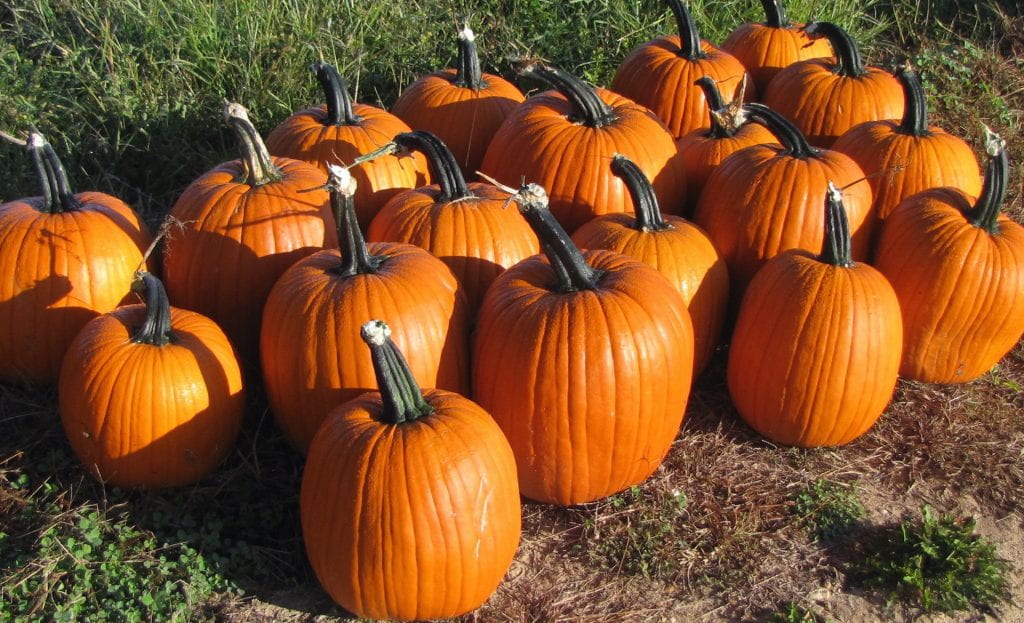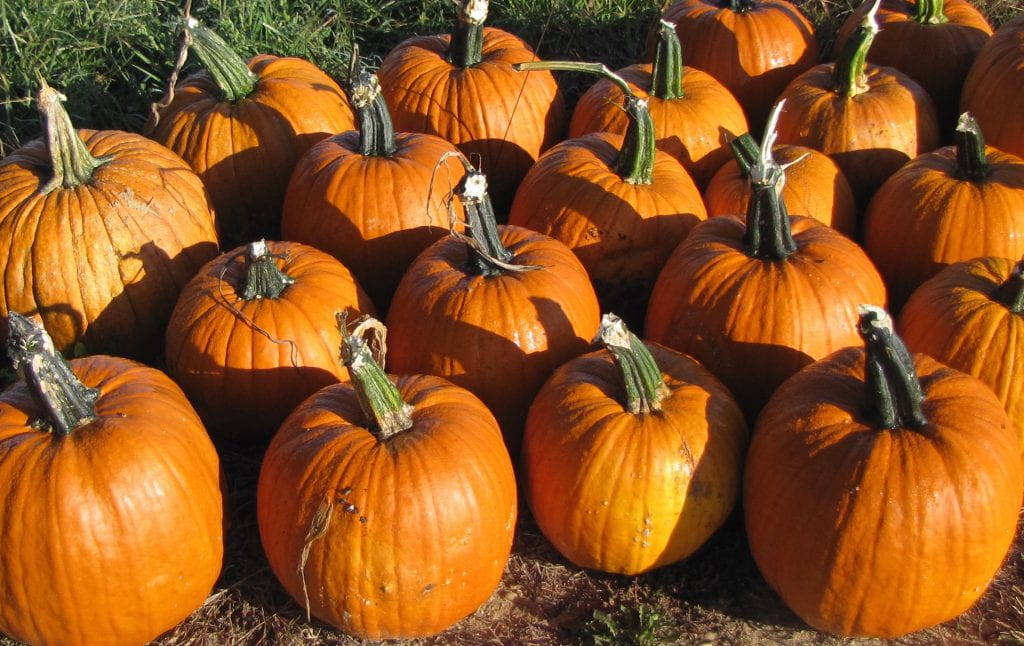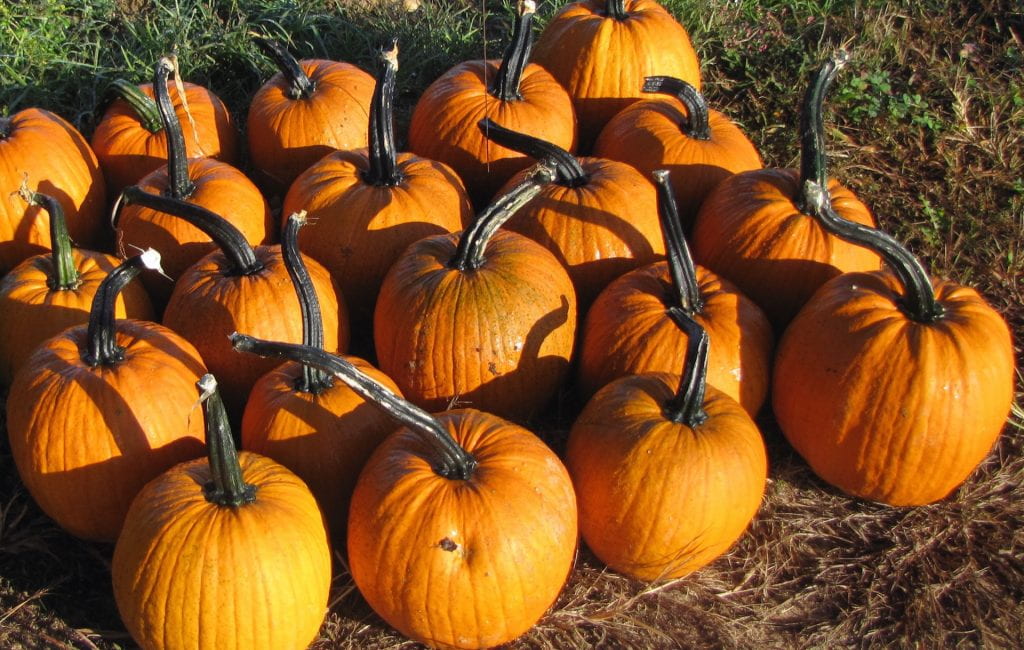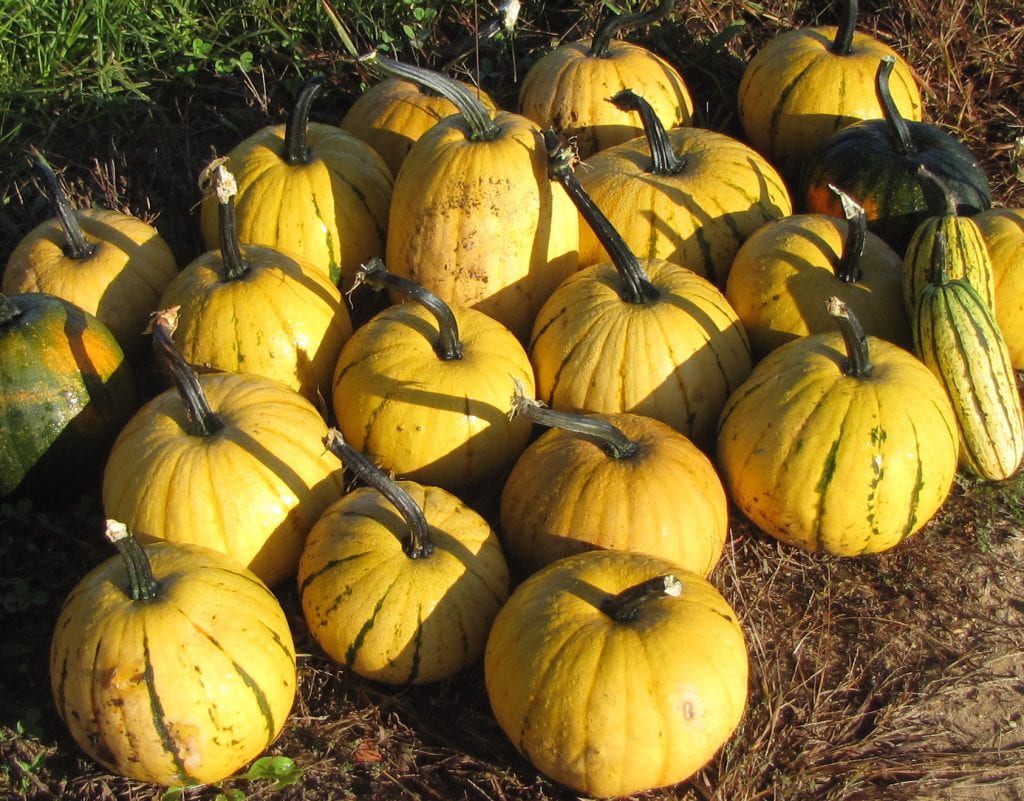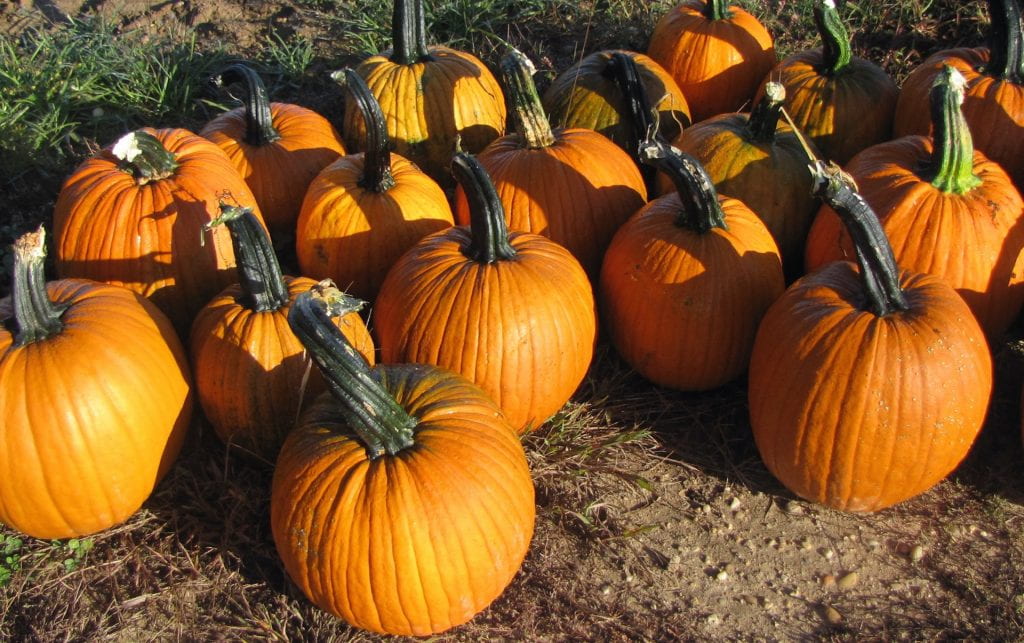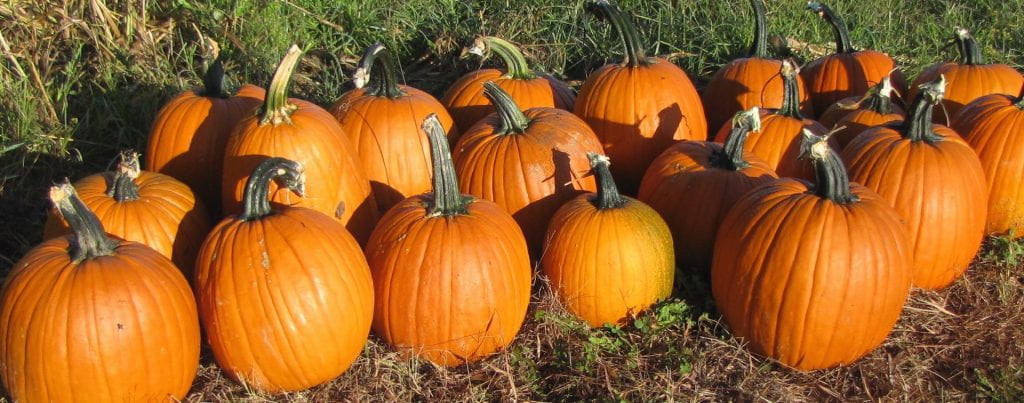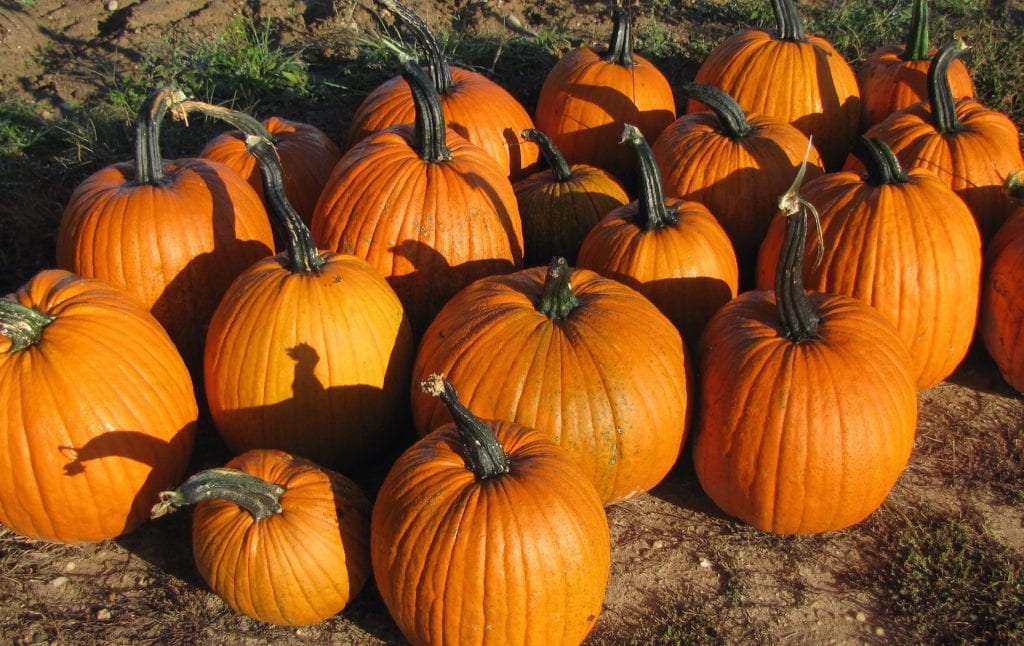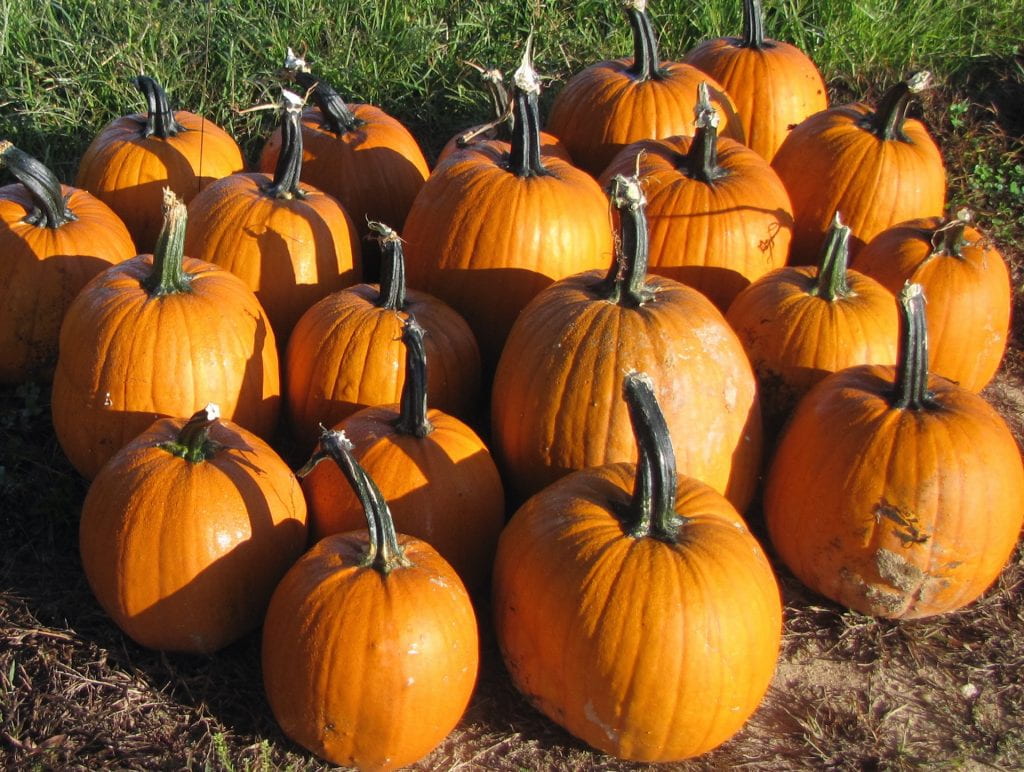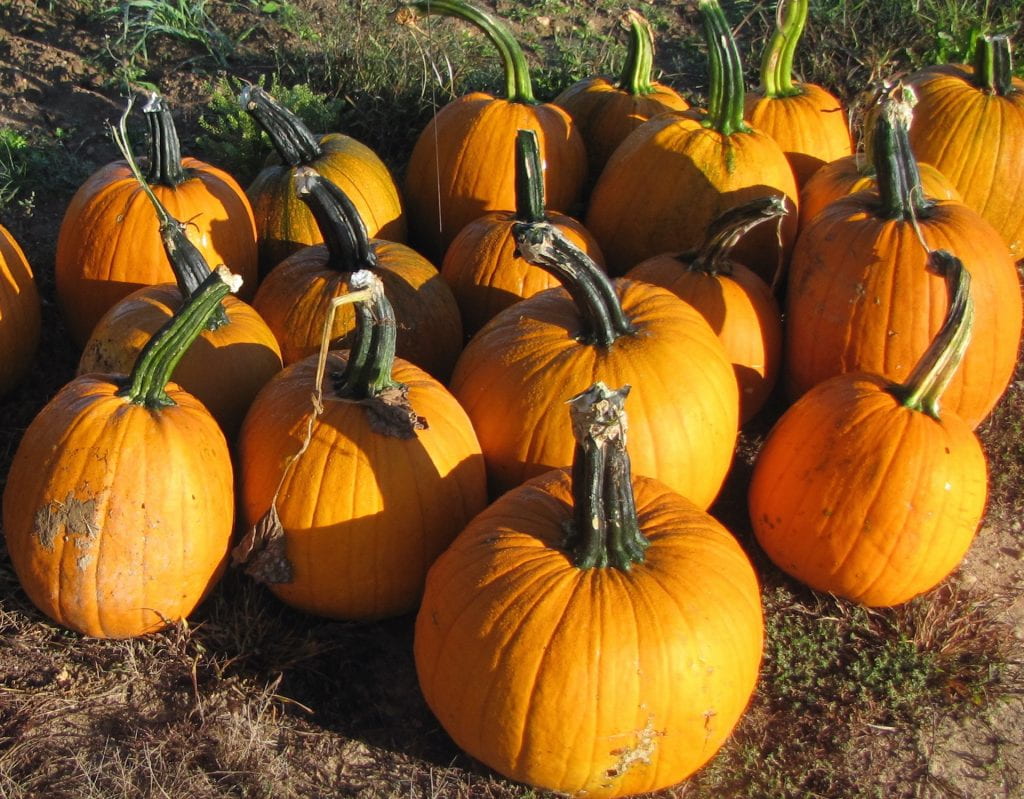This replicated experiment was conducted at LIHREC in 2017.
Topics on this page:
Pumpkins are a very important crop on Long Island. Powdery mildew is the most common disease affecting this crop, occurring every year throughout Long Island. Management is needed to avoid loss in yield and/or quality. When not adequately managed, leaves die prematurely leading to death of vines and pumpkin handles, fruit color can be less intense, and loss of leaves exposes fruit to sunscald. Maintaining solid handles into October is very important for u-pik pumpkins.
Resistant varieties and fungicides are the only management tools. Resistant varieties have been increasing in importance as their number increases. There are few hybrids on the market today that do not have resistance to powdery mildew (PMR). Thus it is now possible to have a planting of all PMR varieties yielding the diversity of fruit types that customers are looking for. When developing an integrated management program, it is valuable to know how effectively powdery mildew can be managed with resistant varieties and whether there are inherent differences in resistance among them to guide selection.
Procedures:
Two experiments with field-grown pumpkins were conducted at the Long Island Horticultural Research and Extension Center (LIHREC) in Riverhead, NY. The goal was to evaluate pumpkin varieties for their ability to suppress powdery mildew when used as the sole management program and also combined with a fungicide program for powdery mildew. Focus was on recently released varieties. Millionaire, an edible ornamental spaghetti-type squash, was also evaluated.
Controlled release fertilizer (N-P-K, 19-10-9) at 525 lb/A (101 lb/A of N) was broadcast over the bed area and incorporated. Beds were formed, drip tape was laid, and beds were covered with black plastic mulch. Plots were three adjacent rows each with three plants spaced 48 in. apart. Seed were hand planted. To separate plots and provide a source of inoculum, two plants of a powdery mildew-susceptible zucchini squash variety (Spineless Beauty) were planted between each plot in each row. The experiment that received a fungicide program for additional control of powdery mildew was sprayed with a tractor-drawn sprayer at weekly intervals starting at first observation of symptoms. The program was: Vivando 15 oz/A on 7 Aug, Torino 3.4 oz/A on 14 Aug, Procure 8 oz/A on 21 Aug, Vivando on 28 Aug, Procure on 5 Sep, Quintec 6 oz/A on 11 Sep, and Vivando on 18 Sep. Plots were assessed for severity of powdery mildew symptoms on upper and lower leaf surfaces on 10, 15, 22 and 30 Aug, and 7, 13, and 22 Sep. Area Under Disease Progress Curve (AUDPC) values were calculated from 30 Aug through 22 Sep. Fruit quality was evaluated in terms of handle condition for mature fruit. Handles were considered good if they were green, solid, and not rotting.
Results:
Through the pair of experiments, it was documented that the resistant pumpkin varieties tested vary in ability to suppress powdery mildew and none provide enough suppression to be used as the only practice to successfully control this disease. In the tables, varieties are organized based on AUDPC values for lower leaf surfaces.
In the absence of fungicide applications for powdery mildew, Progress was the only pumpkin variety able to significantly suppress powdery mildew development on both leaf surfaces based on AUDPC values compared to the susceptible variety Gold Challenger. Skidoo Gold, Eureka F1, and Magnum F1 were significantly less severely affected than Gold Challenger only on the lower leaf surface; however, suppressing powdery mildew there is most important for overall control of this disease.
In the second experiment, the same pumpkin varieties were assessed for powdery mildew resistance with a fungicide program for powdery mildew. Disease levels were very low, as expected, especially on the upper leaf surface, thus there were no significant differences between any of the varieties in those measurements. Progress, Millionaire, Magnum F1, and Eureka F1 were all significantly less severely affected by powdery mildew on the lower leaf surface than the susceptible variety Gold Challenger, documenting the benefit of using an integrated program rather than relying on fungicides alone for managing powdery mildew. While not significant, severity of powdery mildew was numerically less for all of the resistant varieties than for Gold Challenger. Overall larger fruit size and higher percentage of fruit with good handles in the second experiment may be due to the fungicide program improving powdery mildew control. It should be noted that Progress and Millionaire were expected to produce smaller fruit than the other varieties. Overall, no variety was able to significantly outperform Gold Challenger in % defoliation or fruit quality.
Mature fruit from the fungicide-treated experiment were collected and evaluated for overall fruit appearance and handle quality. All of the varieties received the highest possible score for handle quality, 9 out of 9. All also produced high quality fruit based on appearance with Bayhorse Gold receiving a perfect score of 9 and Magnum F1 receiving the lowest score (7). The rest had scores of 7.5 or 8 out of 9.
Conclusion:
The results provide growers information they need to effectively manage powdery mildew, namely that resistant pumpkin varieties are an effective component of the control program, those with homozygous resistance are the best choice, and targeted fungicides also need to be applied to achieve a commercially-acceptable level of control. Similar results were obtained in an evaluation of pumpkin varieties conducted in 2016. In that study, Progress also exhibited best suppression; Superior (PMRR), Rhea (IR), and Ares (IR) were significantly less severely affected by powdery mildew on the lower leaf surface than the susceptible variety Gold Challenger; while Bayhorse Gold (IR), Eagle City Gold (IR), and Kratos (IR) were numerically less severely affected than Gold Challenger.
Margaret Tuttle McGrath
Plant Pathology and Plant-Microbe Biology Section, SIPS, Cornell University
Long Island Horticultural Research and Extension Center
3059 Sound Avenue, Riverhead, NY 11901
mtm3@cornell.edu
Acknowledgments: This project was supported by the National Institute of Food and Agriculture, U.S. Department of Agriculture, Hatch under NYC-153409 and the Friends of Long Island Horticulture Grant Program. Any reference to commercial products is for information only; no endorsement is intended.
Tables
Variety assessment without fungicide program for powdery mildew.
| Powdery mildew severity (%) z | ||||||
| Variety (powdery mildew resistance) y | Upper leaf surface | Lower leaf surface | Pumpkin wt. z | Fruit quality z (% good handles) |
||
| 13 Sep | AUDPC | 13 Sep | AUDPC | (lb/fruit) | 17 Oct | |
| Progress (PMRR) | 32 bc | 232 c | 38 c | 344 d | 10.6 | 49 |
| Skidoo Gold (IR) | 34 abc | 254 bc | 46 bc | 362 d | 14.2 | 31 |
| Eureka F1 (PMRR) | 28 c | 265 abc | 45 bc | 404 cd | 7.1 | 23 |
| Magnum F1 (PMRR) | 33 bc | 279 abc | 53 abc | 508 bcd | 7.5 | 17 |
| Millioniare (PMRR) | 46 abc | 341 abc | 65 ab | 554 abc | 4.3 | 75 |
| Bayhorse Gold (IR) | 46 abc | 357 ab | 68 a | 591 ab | 13.5 | 58 |
| Eagle City Gold (IR) | 52 a | 384 a | 69 a | 608 ab | 12.6 | 22 |
| Gold Challenger (S) | 47 ab | 371 ab | 71 a | 707 a | 11.1 | 20 |
| P-value (variety) | 0.001 | 0.0011 | <0.0001 | <0.0001 | 0.0609 | 0.0453 |
| z Numbers in each column with a letter in common are not significantly different from each other. | ||||||
| y PMRR = homozygous resistance. IR = intermediate resistance. S = susceptible. | ||||||
Variety assessment with fungicide program for powdery mildew.
| Powdery mildew severity (%) z | ||||||
| Variety (powdery mildew resistance) y | Upper leaf surface | Lower leaf surface | Pumpkin wt. z | Fruit quality z (% good handles) |
||
| 22 Sep | AUDPC | 22 Sep | AUDPC | (lb/fruit) | 17 Oct | |
| Progress (PMRR) | 0.00 | 0.01 | 0.0 c | 1.0 c | 11.9 c | 100.0 |
| Millioniare (PMRR) | 0.02 | 0.11 | 0.5 bc | 4.6 bc | 4.5 d | 100.0 |
| Magnum F1 (PMRR) | 0.00 | 0.07 | 0.4 bc | 4.7 bc | 15.8 bc | 96.5 |
| Eureka F1 (PMRR) | 0.02 | 0.10 | 0.4 bc | 4.9 bc | 22.2 a | 100.0 |
| Skidoo Gold (IR) | 0.00 | 0.11 | 2.7 ab | 20.0 ab | 18.6 ab | 100.0 |
| Eagle City Gold (IR) | 0.01 | 0.14 | 2.4 ab | 21.8 ab | 21.2 a | 100.0 |
| Bayhorse Gold (IR) | 0.03 | 0.69 | 3.3 ab | 29.5 a | 20.1 ab | 90.3 |
| Gold Challenger (S) | 0.09 | 0.73 | 4.8 a | 38.9 a | 18.9 ab | 97.7 |
| P-value (variety) | 0.368 | 0.0769 | 0.0004 | <0.0001 | <0.0001 | 0.0961 |
| z Numbers in each column with a letter in common are not significantly different from each other. | ||||||
| y PMRR = homozygous resistance. IR = intermediate resistance. S = susceptible. | ||||||
Images
